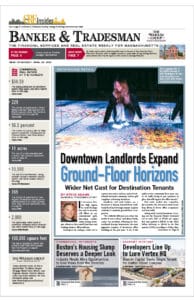
Retailers like Shaw’s supermarkets are moving back downtown to tap underserved markets. Shaw’s recently opened this new store adjacent to the Prudential Center in Boston.
The stock market may be shaky and 401(k) portfolios still losing money, but consumers continue to shop. And while some retailers are faring better than others, at least a handful of big-name corporations new to the region reportedly will soon be vying for market share – and rental space – in Massachusetts and New England.
Peebles Department Store, a Southern-based chain similar to Filene’s; Baja Fresh, a high-end fast-food restaurant; and Edens & Avant, an owner of grocery-anchored shopping centers, are all looking to expand in Massachusetts.
Despite a crippled economy, retailers are still making profits. From 2001 to 2002, total retail sales in the nation increased 4 percent to $1.23 trillion, according to the International Council of Shopping Centers. Store closings were also down, from 7,041 in 2001 to 5,814 in 2002.
“Four percent is healthy; it’s certainly strong,” said Patrice Duker, spokeswoman for the International Council of Shopping Centers. “But we’d love to see higher sales growth. It all [slow sales growth] goes back to the overall economic reasons.”
For retailers, 2003 got off to a rocky start, a trend that more or less has continued through the present. Strapped for cash after what’s been called the worst Christmas shopping season in 30 years, retailers witnessed a slow January as consumers drastically reduced their trips to the mall. February marked another blow to the industry as uncertainty in the Middle East increased. Fast-forward to June. The height of the summer apparel-buying season was crippled yet again – this time by a cold spring.
Consumers are still spending, although not at the same levels seen in the late 1990s.
“Consumer patterns are changing,” said Duker. “They buy something because they need it, not because they want it.”
Discount and specialty stores are among the beneficiaries of the change.
Chico’s total sales in May 2003 reached almost $60 million, a 36 percent increase over sales in May 2002. Dollar General’s May 2003 sales increased 14 percent over May 2002 and Pacific Sunwear’s sales increased 22 percent during the same time period, according to Finard & Co. research.
It’s the department stores that are hurting. “The industry has consolidated and the market has dwindled,” Duker said. “The challenge, in some cases, is figuring out how to reach consumers.”
Ames, Caldor and Bradlees never recovered and the companies’ subsequent bankruptcies left big-box stores and expansive parking lots empty.
“For many developers, it was a blessing in disguise,” said Moss M. Sidell, the state government relations chairman for the International Council of Shopping Centers and law partner at Boston’s Donovan Hatem. “Kmart had been failing for a number of years. It, and stores like it, had been the lifeblood of these centers. Other stores depended on the anchors to draw customers.”
The empty stores simultaneously caused heartache for retail property owners and held the promise of new directions for stale shopping centers. The vacancies also created an opportunity for companies seeking to enter the Massachusetts and New England markets.
For Peebles, a store with a strong presence in the South and mid-Atlantic, moving into former Ames or Kmart stores provides a quick route to established sites known by New England consumers.
“The existing building means that there are no approvals; we just have to find a landlord to put us in there,” said David Bordsen, vice president of real estate for Peebles.
The Last Frontier
New England is typically the last frontier for many national retailers, mainly because of a lack of available land and slow population growth, said Jim Koury, who has worked in retail properties for 18 years and serves as senior vice president at Spaulding & Slye Colliers. Most retailers gain a footing in other parts of the country before searching for suitable locations in the Northeast.
A push into the Northeast by a major market player often has repercussions. When Lowes made its New England debut last year, Home Depot began expanding its locations to maintain its hold on the market.
“What you’ll see is an acceleration of the [leasing] pace from last year,” Koury said.
Retailers are also continuing another trend by opening stores in downtown Boston and other urban centers.
Target has plans for its first Boston store at the former Kmart in the South Bay Center in Dorchester and Shaw’s supermarkets recently opened a new store adjacent to the Hub’s Prudential Center. Wal-Mart is also squeezing its smaller, groceries-only store into inner-city markets. At 60,000 square feet, the stores are less than half the size of Wal-Mart’s usual design.
Companies are becoming more flexible about where they’ll locate, said Dean Holt, senior vice president of real estate for Shaw’s.
“Typically, in the past 10 to 15 years, we were in the suburbs but we’re recognizing the underserved urban areas,” he said.
“Things are somewhat going in reverse, there are a lot of cities that had the retail [and the] retailers went to the suburbs, but now they’re going back,” Sidell said. “A lot of cities are welcoming back retailers.”
Most of the tenant activity in the Massachusetts area is with discount department stores such as Wal-Mart and Target, Koury said. But with the creation of super-centers with a grocery department, Wal-Mart and Target no longer fit into just one retail sector. The resulting hybrids may force a new group of competitors to consolidate, similar to the wave of closings that hit traditional department stores like Caldor and Ames, Koury said.






